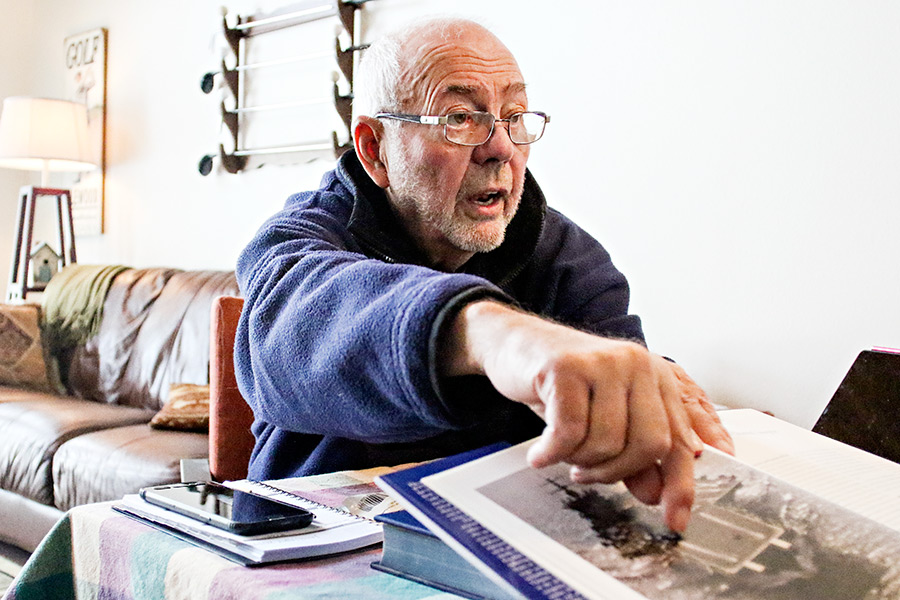Farewell to the USS Enterprise
Bigfork man travels to Virginia for Feb. 3 decommissioning ceremony for historic aircraft carrier he served on in the 1960s
By Justin Franz
In the fall of 1962, the United States and the Soviet Union were on the brink of nuclear war. The USSR had started constructing missile launch sites on the island of Cuba, just 90 miles from the United States.
For days, as President John F. Kennedy wrestled with the volatile situation, the nation was unaware of the looming danger, including Ray Godfrey, a young U.S. Navy machinist aboard the USS Enterprise.
The USS Enterprise, the world’s first nuclear-powered aircraft carrier and the largest ship on earth at the time, had just returned to the U.S. from a tour when it was quickly dispatched back to sea. Crewmembers were told they were heading back out because of a storm, but few believed it. After all, what type of storm could damage a 94,000-ton ship nearly the size of the Empire State Building?
“We felt that the storm was a bunch of baloney,” Godfrey recalled in a recent interview. “Down in the engine room, we had no idea what we were doing but we did know we were heading south because the water was getting warmer.”
On Oct. 22, Godfrey and the crew finally learned their mission when President Kennedy’s address to the nation about what would later be known as the Cuban Missile Crisis was broadcast over the ship’s intercom system. The Enterprise was joining a fleet of U.S. Navy ships patrolling the waters around Cuba to ensure that no more military materials could enter the communist nation.
The Cuban Missile Crisis was just one of the historical events in which Godfrey — now 77 years old and living in Bigfork — participated during his six years aboard the USS Enterprise. Godfrey was part of the first crew when the ship was commissioned in 1961 and is returning this week to Norfolk, Virginia for its decommissioning ceremony.
Godfrey was born and raised in Wyoming and joined the U.S. Navy in the late 1950s. Soon after joining, he was sent to the Naval Nuclear Power School where students were taught the complexities of nuclear-powered ships, such as the USS Enterprise, which the military was building at the time. The nuclear-powered aircraft carrier was the first of its kind and the eighth U.S. naval vessel to be named Enterprise. The ship had eight nuclear reactors powering engines that produced steam to move the ship. It was among the fastest vessels in the Navy’s arsenal.
As part of Godfrey’s training, he and others were sent to Idaho to work on a replica of the Enterprise’s nuclear power plant. In November 1961, the Enterprise was commissioned and pressed into service. Godfrey said working on a nuclear-powered ship could be intense — especially out in the ocean, days away from a friendly port.
“Our performance had to be excellent at all times,” he said. “At the Naval Nuclear Power School, they didn’t teach us how to fix specific things; they taught us how to think through problems.”
Godfrey spent six years on the ship, from 1961 until 1966. Among his missions was when the Enterprise was dispatched to search for the capsule from one of the Project Mercury flights and another to transport a kangaroo from Australia (it was heading to a zoo in the United States). In December 1965, the Enterprise became the first nuclear-powered aircraft carrier to be deployed into combat as part of the Vietnam War.
After Godfrey left the Navy in 1966, he remained interested in the ship. In the 1980s, he got involved with the USS Enterprise Association and later the Naval Historical Foundation. In that role, he helped organize reunions and trips to the ship for other Enterprise veterans. In the early 2000s, he helped fund the construction of a historical display onboard the ship.
In 2012, Godfrey was among a group of special guests for the USS Enterprise’s final “tiger” cruise, which gives sailors a chance to invite friends and family aboard the ship for a multi-day ride. After that, Godfrey took part in the deactivation ceremony.
Since then, the carrier has sat at Newport News, Virginia, where it is being decommissioned, a process that involves defueling the ship and removing its power sources. That process will be completed this month, and Godfrey is flying out to take part in the decommissioning ceremony on Feb. 3, 56 years after he participated in the commissioning ceremony. Godfrey said he looks back at his time aboard the USS Enterprise with pride.
“I feel like what we did was important,” he said. “It was a great ship, it did a great job, and it served our country well.”